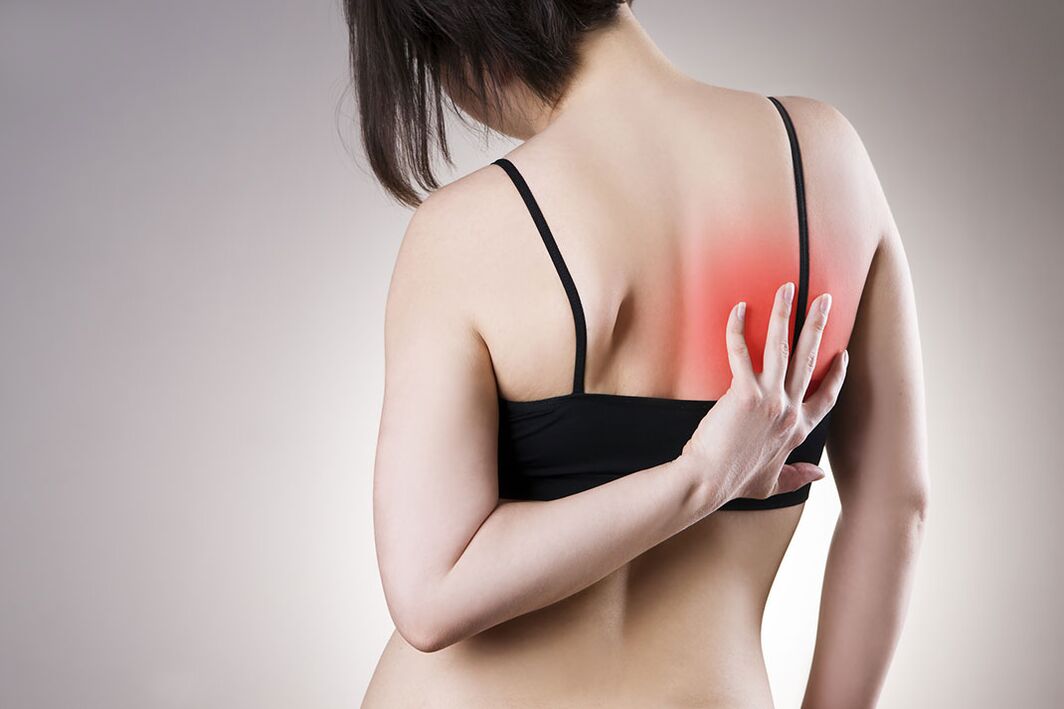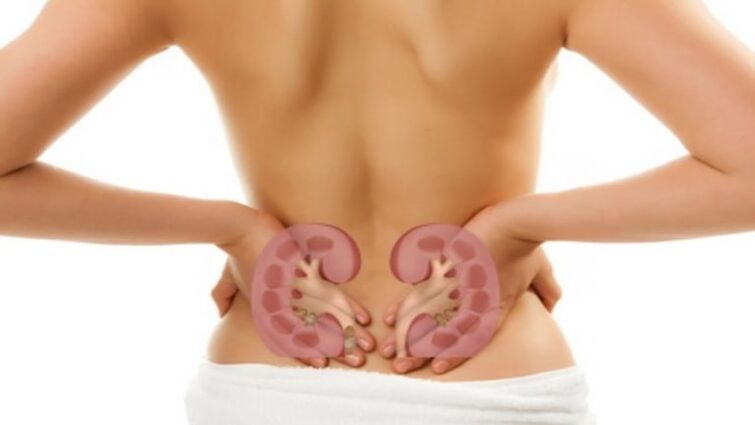
The scapula is a three-dimensional triangular bone that connects the humerus and the clavicle. Its name is due to the external similarity of a well-known tool - a garden shovel. The base of the scapula and the head of the humerus form the shoulder joint, which is the most flexible joint in the human skeleton.
Pain from behind to the right shoulder blade in most cases indicates pathology of the joint elements of the shoulder, spine, or paravertebral (paravertebral) structures. Other possible causes are damage to the internal organs - the bronchi, lungs, kidneys and gallbladder. Persistent pain syndrome in the shoulder blade area almost always indicates a serious problem that requires medical and sometimes surgical treatment.
Muscle tension and inflammation
The shoulder blade is associated with a large number of muscles: subscapular, coracohumeral, small and large rhomboid, deltoid. It most often hurts under the right shoulder because stretching has occurred or an inflammatory process develops.
Muscle stretching can cause severe stress on the back, lifting and carrying weights, sudden movements, and prolonged discomfort. However, practice shows that in more than half of the cases, the cause is excessive physical exertion and improper exercise by the unprepared person.
The symptoms of stretching are as follows:
- sharp pain of varying intensity;
- increased pain as the body rotates and tilts;
- relief during rest;
- swelling and bruising (with serious injury).
The principle of treating sprains is to completely rest and eliminate any stress. Immediately after injury, apply ice or a cold compress to the sore spot and, if necessary, take an anesthetic tablet.
Myositis is a painful pain that increases with pressure and movement. Occasionally, mild swelling and redness occur. Often the general condition worsens: body temperature rises, the head hurts, and tiny painful seals are felt in the muscles.
The causes of myositis are varied, but are most commonly caused by acute respiratory viral infections, influenza, or tonsillitis. It should be noted that muscles in the chest region are relatively rarely inflamed because myositis is primarily localized in the upper back or lower back.
One type is ossifying myositis or fibrodysplasia - an extremely rare form of the disease. This congenital disorder of osteogenesis (bone formation) develops rapidly and manifests itself in childhood.
Fibrodysplasia is the formation of bony points in the muscle structure that gradually enlarge and damage the surrounding tissues. The process of ossification (ossification) can be localized almost anywhere - near the spine, on the limbs or in the pelvic region.
Reference:ossifying myositis is incurable and not suitable for surgical treatment. After removal of the ossifications, they re-form.
Myofascial syndrome
Back pain muscle pain is the most common after a headache. More than 40% of people suffer from chronic pain syndrome, most of them women.
Myofascial syndrome is a progressive condition characterized by the formation of points that trigger (pain) in the muscle. The diameter of each point varies from 1 to 3 mm, the accumulation of points can create a painful area of 1 cm2. These points are caused by trauma and muscle tension.
This process can be triggered by a number of factors:
- skeletal disorders - scoliosis (curvature of the spine to the left or right), pelvic asymmetry, shortening of one limb, flat leg;
- back injuries;
- spinal diseases - osteochondrosis, spondyloarthrosis, and hernia and protrusion;
- long-term use of drugs-β-blockers, cardiac glycosides, calcium antagonists, antiarrhythmic drugs, anesthetics;
- connective tissue damage in autoimmune diseases - rheumatism, lupus erythematosus.
Cholelithiasis
With gallbladder pathologies, pain often radiates to the right shoulder blade. This is due to the spasms of the smooth muscles when the walls of the bladder are irritated by the stones (stones) formed. The onset of bile disease usually occurs suddenly and is concentrated on the right side under the ribs.
Pain syndrome is acute, cutting in nature, and in most cases occurs after consuming fatty, fried, spicy foods and alcoholic beverages. The attack can be caused by severe physical exertion, nervous exertion, or a long slope.
If there is a blockage in the bile duct, the pain may feel dull and pulling. Simultaneous symptoms of difficulty in the abdomen on the right side, as well as nausea, are vomiting. An increase in body temperature is possible, sometimes to high values. As the common bile duct becomes blocked and Oddi’s sphincter becomes blocked, jaundice develops and the stool becomes discolored.
The treatment of gallstones can be conservative and surgical. In the absence of complications, no specific therapy is performed. Single stones can be removed using shock wave lithotripsy.
Subphrenic abscess
The back pain can be explained by the formation of a subphrenic abscess in the area of the shoulder blades - an abscess localized under the diaphragm dome. It most often occurs after abdominal surgery when peritonitis develops. The pathogen may be staphylococcus, streptococcus or E. coli.
The infection enters the body after partial or complete removal of the stomach, resection of the pancreas, suturing of the perforated ulcer, removal of the spleen. This may be due to inflammatory pathology of the internal organs, open or closed abdominal trauma, as well as severe lung lesions, osteomyelitis of the vertebrae and ribs.
First, general symptoms appear - weakness, sweating, and fever. Elevated body temperature may be maintained or may increase periodically. It then begins to ache in the upper third of the abdomen and lower chest from the affected side. Pain syndrome of varying intensity often radiates below the scapula, shoulder, or collarbone.
Characteristic signs of abscess are shortness of breath, dry cough, hiccups and increased pain while moving, deep breathing, coughing and sneezing. The patient breathes frequently and superficially, trying to assume a semi-sitting position.
Treatment of subphrenic abscess involves surgical opening and removal of the abscess, followed by antibacterial, poisoning, inflammation, and restorative therapy.
Reference:if the surgery is not performed in time, the abscess breaks through the abdominal and pleural cavities, almost guaranteeing a fatal outcome.
Pleurisy
Pain near the shoulder blade can cause bronchitis - pneumonia - pneumonia or bronchitis, which is complicated by pleurisy. In this case, it can hurt below and above the shoulder blade. However, the main source of pain is the chest and upper abdomen.
Pleurisy is always a complication of other diseases, including malignancies. This can be caused by bacterial, viral or fungal infections, trauma and chest surgery.
In some cases, pleurisy develops in the background of autoimmune diseases - scleroderma, rheumatoid arthritis, lupus erythematosus, vasculitis, as well as pulmonary thromboembolism, myocardial infarction, pancreatitis.
25% of patients with pleurisy are diagnosed with a malignancy - mesothelioma or metastases of other organs (breast, ovary). Metastatic pleurisy is usually associated with mild symptoms and often manifests itself only in pain behind the sternum.
If large amounts of secretion accumulate, it should be emptied or drained. Depending on why pleurisy has developed, special treatment is prescribed. It may contain antibiotics, steroids, anti-inflammatory drugs. The form of tuberculosis is treated with special drugs.
Urolithiasis disease
The formation of stones in the urinary system is most common in middle-aged people - between 25 and 50 years of age. The disease progresses in different ways: in some cases, the symptoms are limited to a single unpleasant episode, while others complain of regular exacerbation. In some cases, urolithiasis is chronic with a prolonged course.
The main symptom is renal colic when the ureter is blocked. The localization of pain syndrome depends on the location of the stone and the intensity depends on its size. Right shoulder pain occurs when the right kidney is affected. If the stone is lower, it will hurt your waist or abdomen.

Typical symptoms of urolithiasis are frequent urge and burning sensation when urinating, fever and nausea.
The method of treatment can be conservative or surgical. The most common action required, the indications for its implementation are as follows:
- large stones;
- development of renal failure;
- localization of the calculus in the kidney, renal pelvis, or ureter;
- purulent pyelonephritis.
The surgery can be open or endoscopic. Shock wave lithotripsy is the most gentle method to reduce the percentage of postoperative complications.
During the operation, the stones are crushed using a reflector that emits electro-hydraulic waves. After grinding, stone particles and sand are excreted in the urine. Sometimes their movement along the ureter causes kidney colic, which can be easily stopped with medication.
Reference:not all operations guarantee the absence of relapses. Therefore, it is necessary to perform a complex therapy that can take several years.
Intervertebral neuralgia
Intercostal neuralgia (thoracalgia) is characterized by severe symptoms and most often acute, stinging pain occurs in the ribs, both in the front and back. It may appear intermittent at times or continuously. Pain syndrome is sore, burning, or dull, but always hard to bear.
A characteristic sign of neuralgia is a sharp increase in pain when inhaling, changing posture, or sneezing. Often during a painful attack, the muscles twitch, sweating increases, the skin turns red or, conversely, pales. Numbness occurs at the site of damage to nerve endings.
The direct cause of the pathology is the stinging of the nerve roots, which is facilitated by various factors and diseases:
- osteochondrosis;
- spondylitis;
- ankylosing spondylitis;
- primary and metastatic tumors;
- upset stomach (gastritis);
- age-related changes in blood vessels;
- metabolic disease;
- chest trauma;
- influenza, SARS;
- hypothermia and drafts;
- persistent or severe nervous stress;
- high physical activity;
- unsuccessful rotation of the body, longer stay in a static position.
Reference:intercostal neuralgia is characterized by pain lasting from a few seconds to three minutes. During this time, the patient tries not to breathe or move so as not to increase the pain.
The main focus of treatment is to relieve the pain syndrome for which non-steroidal anti-inflammatory drugs (NSAIDs) are prescribed. In severe pain, therapeutic blockages with anesthetics and steroids are performed. Sedatives are used to increase the threshold for central nervous system irritability.
Specific therapy depends on the origin of the neuralgia and may include antiviral, antihistamines and muscle relaxants.
Neoplasms
Shoulder bone tumors are very rare, can be benign or malignant. The former include osteoma and chondroma, the latter chondrosarcoma and Ewing sarcoma. An osteoma is characterized by slow growth and a favorable course. It mainly affects children and young people between the ages of 5 and 20.
An osteoma can grow asymptomatically and only manifest itself when the surrounding structures — nerve roots and blood vessels — are compressed. The treatment is only surgical, there is virtually no relapse.
Chondroma is a benign tumor that comes from cartilage tissue. It should be noted that when the chondroma is localized in the shoulder blade, the tumor often progresses to malignancy. Due to the high risk of malignancies, such formations are radically removed.
Chondrosarcoma, like chondroma, is formed in cartilage tissue but is malignant and widespread. The increase is accompanied by increased pain and swelling in the affected area.
Chondrosarcoma occurs in people of any age, even children, but the highest percentage is in middle age - between 40 and 60 years. It is men who suffer the most. The main method of treatment is to remove the tumor; if it is impossible to perform the operation, chemotherapy and radiation therapy will be performed.
Ewing sarcoma is one of the most aggressive malignancies that is prone to early metastases. It affects children and young people and manifests itself in severe symptoms - pain, swelling and redness.
Because the tumor is extremely aggressive, surgical and therapeutic treatments are also performed. Both before and after surgery, chemotherapy and radiation therapy are performed, as well as using high doses and a variety of medications. The prognosis of the disease is conditionally unfavorable.
Pain under the right shoulder blade can be a completely harmless symptom or a sign of a serious illness. A specialist consultation and examination is needed to relieve pain and prevent possible complications. Based on your results, your doctor will prescribe treatment and make any necessary recommendations. Being healthy!



































